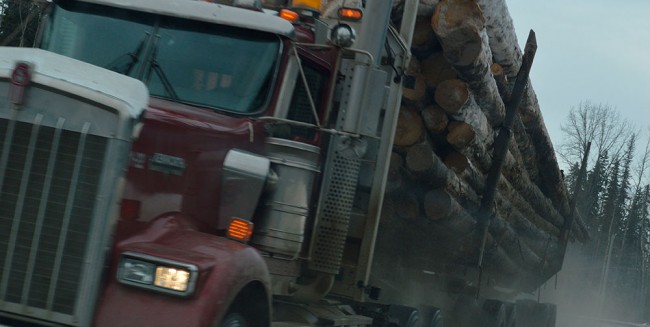
Photo Credit: Photo Mark West
Driving BC’s Radio-assisted Logging Roads
If you’re new to the North and you’ve come from a place that’s less wild and rugged, you may be unsure about driving radio-assisted logging roads. Even if you’ve lived here for 20 years, you might still be unsure! I come upon places where the road narrows to one lane and a sign says, “Use Maxan Channel 151.115 MHz,” and I think things like, Do I need to have a radio if I want to drive on? Is it a law? If I had a radio, how would I use it? Where do I get one? Is it expensive? Do I need a radio licence?
The history of BC’s resource roads, as they are officially called, begins with the fact that it’s much cheaper to build a one-lane road than a two-lane one. There are hundreds of kilometres of these roads in the province, bearing romantic names like Nilkitkwa and Holy Cross and providing access to remote areas where logging and mining—and prospecting and pipeline building—are taking place.
Vehicles, from logging trucks to ore-hauling trucks to pickups, have been using radios to broadcast their locations on these roads for a long time. It helps to avoid accidents and radios are now required for anyone working out there. WorkSafeBC sets this requirement, since most people on these roads are in the workplace. The term radio-assisted is used instead of radio-controlled to convey that radios are optional and drivers should be aware of vehicles travelling unannounced.
In 2015 the system is still mostly a diverse bunch of locally organized roads and frequencies, and a coordinated, province-wide system is only now being put in place. Recently, the way that one calls his or her direction was standardized (to up or down rather than loaded or empty, in or out), and over the next five years the radio frequencies will become a single set of 40 channels that work no matter where you are in BC, Alberta and the Yukon.
For someone who wants to use a radio-assisted road to go hiking, skiing or fishing, bear that word workplace in mind. Although there is no law that says you can’t drive out there, it’s important to respect the drivers who are out there on the job and to use the protocols they use. Your presence is not really part of the plan. Although the system is being standardized, there is no current public information program, like a website where you could go when planning your trip to see a map of the radio-assisted resource roads and their frequencies.
According to Ministry of Forests chief engineer Brian Chow, “There are very few roads in BC that are actually radio-controlled. The vast majority are merely radio-assisted, which means that you must drive with caution and assume you are sharing the road with vehicles without radios.”
But the alternative to using a radio is a bit disquieting. It has been suggested to me that I just wait at the beginning of the road for an empty logging truck to come along, and then to follow it. When it pulls over, I pull over behind it. A second strategy was to only drive these roads on the weekends, assuming no logging activity happens at that time. A third strategy was to rely on the fact that much of the time vehicles with radios will call for radio-less vehicles that they see. “Vehicle at kilometre 16, do you have a radio?” Not receiving an answer, they will call, “Vehicle at 16, up, no radio.”
Well, OK, I guess these methods have worked. But on the other hand, hearing about them was a little bit like those conversations where people confide methods for avoiding pregnancy without using contraceptives. It sounds, you know, a little bit sketchy. I’m thinkin’: Don’t risk it—use a radio.
Radios can be rented from a number of places, such as Helix Electronics in Smithers, Coast Mountain Radio in Terrace, Tower Communications in Houston or Central Interior Communications in Prince George. Helix, for example, will rent you a radio for a week for $30. It plugs into your cigarette lighter and there’s a magnetic antenna that goes on your roof. (Handheld radios do not function well from inside vehicles and will not give you the range you need.) Tell the company where you are headed and they can make sure the radio has the right frequencies.
You don’t need a radio licence, but you do need to know how to use the radio. WorkSafeBC assumes the employer trains the employee, but that doesn’t apply in our weekend-warrior case. The first thing to learn is the distinction between up and down. You’re driving up when the numbers on the kilometre markers you are passing are going up. (Most radio-assisted roads begin with KM 0 and a sign telling you the frequency and how often to call.) If the kilometre-marker numbers are going down, you’re driving down.
Note that up and down don’t have anything to do with whether you’re going uphill or downhill!
The calling protocols vary from road to road and, again, are described on the initial sign you see. The protocol might be to call every two kilometres when going up and every two kilometres when going down. It might be to call every two kilometres when going down but to be silent (and listening) when going up. It might be something else entirely.
The way to make your call is pretty simple: say the road name, your current location, your current direction and your vehicle type. So, for example, if your party is in two cars headed up at KM 4 on the Holy Cross FSR, you press the transmit button and say, “Holy Cross, four, up, two cars.”
Down traffic always has the right-of-way, so you need to pay attention to where the other vehicles are who are calling. Generally speaking, industrial vehicles headed down are “loaded” (think, loaded logging truck). However, if you hear someone calling up with a “low-bed” they may be hauling a piece of heavy equipment in and from your point of view they should probably get right-of-way even if you’re going down.
When you get near to someone headed in the opposite direction, pull off the road in a visible location (not on a curve or the crest of a hill) and wait for them to pass.
Note that there are must-call spots. These might be tight corners or blind spots and you call here in addition to the regular calls you are making. These spots have specific must-call signs that tell you what to call and in which direction.
A smart procedure at the beginning of a radio-assisted resource road is to stop and turn your radio on and take a moment to monitor the radio traffic in the area. Is it a busy day? Is there no one out there at all? If there is traffic, then before proceeding perform a radio check by calling the road name and, “Zero, up, one car—can you hear me?” Getting a response tells you that your radio is both transmitting and receiving. Then you can begin driving.
By now you’ve probably figured out that this is not like driving to the store for a jug of milk. You have to have your wits about you. During this time of transition to the new frequencies, you should drive with extra caution. You are, in effect, entering a workplace used by multiple organizations and trying to fit into the safety procedures they use. Nonetheless, people on the job out there would prefer you use a radio.






thanks ! great, informative article, planning on doing bunch of boondocking this year in BCand knowing about protocals and being able to use the system is invaluble.
cheers
karl
👤 karl roth 🕔 Jul 05, 2015